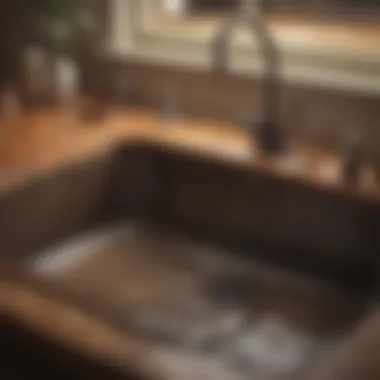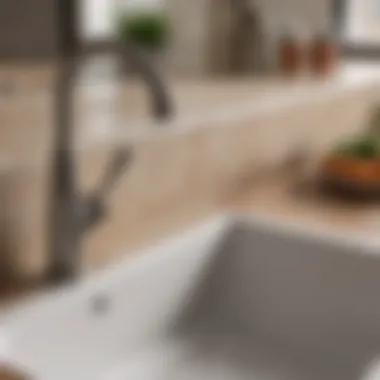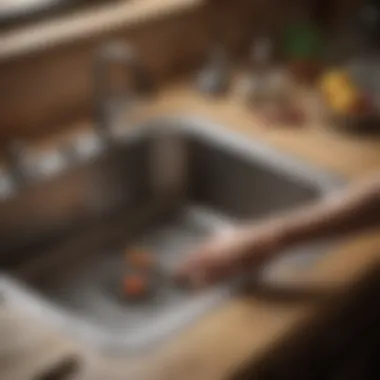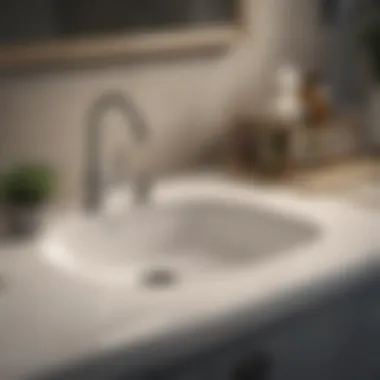Effective Solutions for Fixing a Clogged Sink


Intro
Clogs often arise from various factors, such as food particles, hair, soap scum, or mineral buildup. When these materials accumulate, they obstruct the flow of water, leading to slow drainage or complete blockage.
Addressing a clogged sink should not be an overwhelming task. Through this structured approach, individuals can diagnose and resolve clogs effectively. The aim is to provide clear, detailed guidance to alleviate the hassle of dealing with such plumbing issues. Not only will this assist with immediate fixes, but it will also highlight preventative measures that can keep your sink functioning optimally in the long run.
Key Insights and Trends
Being aware of current trends in home maintenance can enhance your approach to fixing common issues like sink clogs. Today, many homeowners value sustainability and preventive practices in plumbing maintenance. Below are insights relevant to sink care and maintenance.
- Eco-friendly solutions: Many individuals are moving towards natural remedies for fixing clogs. Ingredients like baking soda, vinegar, and salt can effectively break down buildup without harsh chemicals.
- Smart home technology: Innovations in plumbing technology are encouraging homeowners to monitor their plumbing systems. Leak detection devices and smart sinks offer new ways to avoid clogs before they occur.
- Frequency of maintenance: Regular checks and cleaning can prevent major problems. Homeowners are increasingly aware that dedicating a few minutes each month can save costly repairs later.
Practical Tips and How-To Guides
Diagnosing the Clog
- Observe water drainage patterns. Is it slow, or does it back up entirely?
- Check adjacent sinks or fixtures for related issues.
- Use a flashlight to look inside the drain for visible obstructions.
DIY Solutions
Using Baking Soda and Vinegar
- Pour a half-cup of baking soda down the drain.
- Follow with a half-cup of vinegar.
- Cover the drain and wait for 30 minutes.
- Rinse with hot water.
Plunging
- Ensure there is enough water to cover the bottom of the sink.
- Place the plunger over the drain and push down firmly.
- Pull up sharply, creating a vacuum effect to dislodge the clog.
Preventative Measures
- Regular cleaning: Use a mixture of baking soda and vinegar each month to prevent buildup.
- Avoid certain items down the drain: Keep hair strands and food scraps out of the sink.
- Invest in a drain strainer: This inexpensive tool can dramatically reduce debris entering your plumbing system.
"A proactive approach can save time, money, and frustration in maintaining sink functionality."
Maintaining Your Sink
Routine checks can fortify your sink against future clogs. Examine for leaks or signs of wear. Regularly cleaning strainers and disposing of waste properly can also improve performance. By employing both short-term fixes and long-term maintenance strategies, homeowners can ensure their sinks remain functional and efficient.
Through this guide, it becomes evident that a clogged sink does not have to be a daunting challenge. With the right knowledge and tools, resolving this common household issue is achievable.
Foreword to Clogged Sinks
A clogged sink is a common household issue that can disrupt daily life. Understanding this topic is crucial for homeowners and renters alike. The inconvenience caused by a blocked sink extends beyond mere annoyance. It can lead to further plumbing complications and affect overall hygiene in your property.
Understanding the Problem
A clogged sink often arises due to a mixture of substances that accumulate over time. Commonly, food debris, grease, hair, and other materials get trapped within the pipes. This accumulation slows down drainage and can ultimately lead to total blockage. Knowing the signs of a clog is essential. Watch for slow drainage or unusual odors, as these are early indicators of a problem that could worsen if ignored.
Being proactive in addressing clogs can save you time and money. It is beneficial to familiarize yourself with common causes and prevention strategies to minimize future issues.
Importance of Timely Intervention
Timing is critical when dealing with clogged sinks. If left unresolved, the situation can escalate, leading to severe plumbing problems. Water may overflow or cause extended damage to cabinetry or flooring. Timely intervention helps avoid costly repairs or replacements.
Addressing minor clogs can often be achieved with simple DIY methods, but waiting too long might necessitate the help of a professional. Regular maintenance checks can mitigate these risks. Preventive practices ensure the systems in your home remain functional and efficient.
In essence, understanding and respecting the importance of your plumbing can significantly enhance your living conditions.
Common Causes of Clogs


Understanding the common causes of clogs is essential for anyone who manages a sink, whether in a home or a commercial setting. A clogged sink can disrupt daily routines, create hygiene issues, and lead to costly repairs if not addressed promptly. Recognizing the factors that contribute to sink clogs helps in both prevention and diagnosis.
Identifying specific causes can guide individuals to implement more effective prevention strategies. It also enables them to take appropriate actions when a clog occurs. Being aware of these elements is critical, particularly in the diverse environments where sinks operate, which may have unique combinations of challenges.
Food Debris and Grease Accumulation
Food debris and grease are significant contributors to sink clogs. When food particles are washed down the drain, they can accumulate over time. Grease, specifically, hardens and solidifies in the plumbing system, forming blockages that significantly hinder drainage.
The kitchen sink is particularly vulnerable as it is often the primary site for food disposal. Washing dishes without properly scraping off excess food can lead to gradual accumulation. Additionally, pouring grease down the sink is a common but detrimental practice that can quickly lead to serious clogs. Homeowners can benefit from routinely cleaning sink traps and using strainers to catch food particles.
Hair and Personal Care Products
Another prevalent cause of sink clogs is hair combined with personal care products. Hair strands tend to cling to one another and can trap other substances, including soap, shampoos, and conditioners. When hair collects in drains, it creates a dense barrier that obstructs water flow.
Bathroom sinks often experience this problem more than others. Regular cleaning of sink surfaces and drains can minimize hair accumulation. Using drain catchers can prove useful to capture loose hair before it can further move into the plumbing system, thus ensuring smoother drainage.
Foreign Objects in the Drain
Foreign objects accidentally introduced into a sink can result in immediate and significant clogs. Items such as small toys, wrappers, or even pieces of jewelry can easily obstruct water flow. Aside from being an inconvenience, these clogs can lead to more severe plumbing issues.
To avoid this, it is vital to educate household members on proper sink usage. Setting clear boundaries around what can or cannot be disposed of in sinks will help minimize such risks. In cases where objects are known to be stuck, careful assessment and retrieval are crucial to restore optimal drainage.
Prevention Strategies
Preventing sink clogs is a crucial aspect of maintaining a smoothly functioning household. Prevention strategies are essential for homeowners and renters alike. These methods not only save time and money but also enhance the overall life span of your plumbing system. Understanding how to keep your sink clear of obstructions can minimize the need for frequent repairs and professional interventions.
Regular Maintenance Checks
Regular maintenance checks are an indispensable part of preventing clogs. This proactive approach involves inspecting your sink and drainage components on a consistent basis. Homeowners should prioritize tasks such as:
- Examining the sink area for any signs of moisture or leaks, as these can signify underlying issues.
- Checking pipes exposed under the sink for any rust or wear, which might lead to leaks or cracks.
- Clearing debris from the sink strainer frequently to prevent buildup.
By adopting this routine, you can spot potential problems before they escalate. Noticing early signs of a blockage often leads to straightforward solutions that require minimal effort. Regular checks save time spent on tedious repairs and also preserve the integrity of your plumbing system.
Using Drain Screens
Utilizing drain screens is an effective and simple method for protecting your sink from clogs caused by food particles and hair. These handy devices are installed over the drain and effectively catch debris before it enters the pipes. Some key benefits of using drain screens include:
- Reduced Frequency of Clogs: By trapping larger objects, screens dramatically decrease the amount of waste entering the drainage system.
- Ease of Cleaning: Cleaning a drain screen is straightforward; simply lift it out, discard the trapped debris, and rinse it off.
- Cost-Effective Solution: The small investment in drain screens can save you substantially in plumbing repairs over time.
For maximum effectiveness, choose screens that fit your sink size and that are made from durable materials to withstand regular use.
Educating Household Members
Educating all household members on proper sink usage is vital for maintaining clear drains. When everyone understands what can safely go down the sink, it minimizes the risk of clogs. Here are some points to cover with your household:
- Proper Disposal of Food Waste: Educate family members not to send large food particles down the sink, encouraging them to use a compost bin or the trash.
- Awareness of Fats and Oils: Discuss the impact of pouring grease or oil down the drain, which solidifies and leads to significant blockages.
- Hair Management: Make sure everyone understands that hair should be disposed of in the trash rather than washed down the sink.
By fostering an environment of awareness and responsibility, you can significantly reduce the likelihood of clogs. Ensuring everyone is informed turns prevention into a collective effort.
"Prevention is always better than cure. Investing in preventive measures can save you substantial inconvenience in the long run."
By implementing these prevention strategies, you can enjoy a more efficient sink system and minimize the risks associated with clogs, thus enhancing your home's overall health.
Tools Required for Fixing Clogs
When addressing sink clogs, having the right tools is essential. These instruments enable a systematic approach to elminating the blockages in an efficient manner. Using the appropriate tools can save time, reduce frustration, and often avoid additional damage to the plumbing system.
Equipping yourself with the right tools also allows you to perform repairs safely and effectively, which is crucial for maintaining a healthy home environment. Additionally, understanding which tools serve specific purposes, and how to use them correctly, enhances your confidence in tackling such tasks.
Essential Tools


To effectively tackle clogs, certain tools stand as must-haves in every household. These tools tend to provide versatility and ease in handling blockage issues. Here are several essentials:
- Plunger: A basic but powerful tool designed to create suction in drains, dislodging clogs caused by solid materials. It is particularly effective for sinks and toilets.
- Drain Snake: Also known as an auger, this flexible tool can reach deep into pipes to break up or extract stubborn clogs, especially those formed by hair or foreign objects.
- Baking Soda and Vinegar: While not traditional tools, they are highly effective. This natural mixture can dissolve grease and buildup while also deodorizing the drain.
- Boiling Water: Again, not a tool in the conventional sense, pouring boiling water can address certain types of clogs, particularly grease.
- Adjustable Wrench: Handy for tightening or loosening drain components, this tool can assist in clearing blockages when the plumbing requires manual manipulation.
- Plumber's Tape: Useful for sealing any threads when reassembling pipes, preventing leaks after maintenance.
Having these tools ready can allow for a prompt response to a clogged sink situation.
Safety Gear Recommendations
Safety should always be a priority during plumbing repairs. When dealing with clogged sinks, certain protective gear can help mitigate risks associated with potential chemical exposure or physical injury. Here are a few recommended items:
- Gloves: To protect your hands from corrosive substances and germs present in clogs. A pair of durable rubber gloves is ideal.
- Safety Goggles: Essential for protecting your eyes from splashes, especially when using chemicals for unclogging.
- Face Mask: This can help reduce exposure to harmful fumes released by certain drain cleaners or stagnant water.
- Knee Pads: If you need to kneel while working, these can provide comfort and protect your knees from hard surfaces.
It's vital to wear appropriate safety gear and use tools correctly to avoid accidents while unclogging your sink. Thus, investing in the right equipment not only protects you but can lead to more successful plumbing outcomes.
Initial Assessment
Before tackling a clogged sink, it is crucial to conduct an initial assessment. This stage can save both time and effort. Identifying the clog and understanding its implications allows you to choose the most effective resolution method.
Identifying Signs of a Clog
Recognizing the early signs of a clog is essential for effective solutions. Common indicators include:
- Slow drainage: Water takes longer than usual to go down the drain. This often suggests that debris is accumulating.
- Unpleasant odors: Bad smells can indicate decomposing food or stagnant water, hinting at a significant buildup.
- Gurgling sounds: These noises may occur when air bubbles pass through standing water, suggesting an obstruction.
These signs can vary depending on the type of sink. For instance, kitchen sinks may show food debris signs, while bathroom sinks can reflect hair accumulation. Being attuned to these symptoms allows for timely intervention.
Evaluating the Drainage Flow
Once signs are identified, assess the drainage flow. You can do this by observing how quickly water moves when the faucet is turned on. Here is a simple approach:
- Fill the sink: Start by filling the sink with water to a reasonable level, about halfway.
- Observe the emptying: Let the water drain and time how long it takes. Under normal conditions, water should drain in a few seconds.
- Note any irregularities: If you notice slow drainage or if water backs up, there is likely a clog that needs attention.
Evaluating flow effectively narrows down the specific issues to address. It aids in determining whether a standard fix suffices or if professional assistance is warranted.
Conducting both identifying and evaluating measures will help determine the appropriate course of action. These steps form the foundation of resolving a clogged sink effectively, ensuring a more manageable process and potentially sparing you from further complications.
DIY Methods for Unclogging
The ability to resolve a clogged sink efficiently is vital for maintaining a functional household. DIY methods provide accessible solutions for homeowners looking to tackle minor plumbing issues without resorting to professional help. Utilizing these methods can save both time and money. Moreover, it empowers individuals with practical skills that are applicable for various circumstances. By familiarizing oneself with these techniques, one also embraces a mindset of proactive home maintenance.
Boiling Water Technique
The boiling water technique is among the simplest yet effective approaches to unclogging a sink. Start by boiling water in a kettle or a large pot. Once it reaches a rolling boil, carefully pour the hot water directly down the drain. This method is most effective for clogs caused by grease or soap buildup. The high temperature can help break down these substances, effectively flushing them away through the pipes.
However, caution is important. Always ensure that the pipes are compatible with boiling water. For instance, certain PVC pipes may be sensitive to extreme heat, potentially leading to damage. If unsure, consider an alternative method.
Baking Soda and Vinegar Approach
The combination of baking soda and vinegar is a renowned DIY solution for various cleaning tasks, including sink unclogging. Begin by pouring half a cup of baking soda directly into the drain. This should be followed by half a cup of vinegar. The mixture will fizz and bubble, a reaction that can help dislodge debris clogging the pipe.
Allow the solution to sit for approximately 30 minutes. After this waiting period, flush the drain with hot water. This method effectively tackles minor clogs, particularly those involving organic matter.
Plunger Usage
Using a plunger is perhaps the most common strategy for resolving clogs. Ensure that the sink has a few inches of water to create a proper seal with the plunger's suction cup. Position the plunger over the drain and plunge vigorously, pushing down and pulling up rapidly.
The pressure created by the plunger can help dislodge the blockage. In some cases, repeated plunging is necessary to achieve desired results. Consider performing this process for several minutes until you notice a change in drainage.
When using a plunger, ensure that it is clean and dedicated for sink use; cross-contamination can lead to complications in hygiene.


Drain Snake Application
A drain snake, or auger, is a vital tool for anyone dealing with stubborn clogs. It consists of a flexible metal coil that can navigate the twists and turns of pipe systems. To use a drain snake, insert it into the drain, turning it as you push deeper to reach the clog.
Once resistance is felt, rotate the snake to break up the blockage. Carefully withdraw the snake, taking care to remove any debris that has clung to it. This method is particularly effective for hair clogs or foreign objects lodged in the drain.
Regular use of these simple methods can eliminate most sink clogs without heavy-duty tools or expensive contractors.
When to Call a Professional
Clogged sinks can often be managed through DIY methods. However, there are situations when calling a professional is not just advisable but crucial. Homeowners should know the signs that indicate the need for expert help. Understanding these indicators can prevent further complications and provide peace of mind. Having a professional evaluate the situation can save time, money, and frustration.
Identifying Persistent Problems
Sometimes, a sink may appear clogged, but minor fixes do not resolve the issue permanently. If you notice reoccurring clogs despite your best efforts to clear them, it’s a signal to seek professional assistance. Persistent issues might mean your plumbing system has underlying problems that require professional tools and expertise.
Common signs that indicate persistent problems include:
- Slow drainage: If water consistently drains slowly, it could signify a larger obstruction deeper in the pipeline.
- Multiple fixtures affected: If more than one sink or fixture is experiencing clogs simultaneously, it may indicate a blockage in the main sewer line.
- Unpleasant odors: Foul smells can suggest issues within the pipes that may require deep cleaning or repairs.
- Frequent need for unclogging: If you find yourself reaching for your plunger repeatedly within a short period, a professional can assess and resolve potential systematic issues.
It is vital to act promptly when you notice persistent issues. Delaying can escalate the problem, leading to more extensive damage, which could be costly.
Understanding Complex Drainage Systems
Not all plumbing systems are straightforward. Some homes have complicated drainage layouts that can confuse even experienced individuals. If your home has an intricate system, a professional plumber can provide invaluable insight.
Dealing with systems that include:
- Multiple branch lines: Often, the way your drains connect can complicate situations.
- Sewer ejector pumps or lift stations: These components require special knowledge and familiarity.
- Old or outdated plumbing: Older systems can have specific quirks that demand an expert’s touch for effective troubleshooting.
Understanding the specifics of your plumbing can determine the right course of action. Assessing your plumbing layout and its components is crucial in determining whether you should seek professional help. Trying to address complex systems without adequate knowledge and tools can lead to further complications, including potential code violations and safety hazards.
Impact of Clogged Sinks on Home Health
Clogged sinks are not merely a nuisance; they can have significant implications for home health. This section underscores the critical connection between clogged sinks and overall hygiene, sanitation, and structural integrity of a home. Homeowners must understand these impacts to prioritize proper maintenance and swift action when clogs occur.
Effects on Hygiene and Sanitation
A clogged sink can directly compromise hygiene in several ways. When water cannot flow freely, it creates a breeding ground for bacteria and mold. Stagnant water is highly susceptible to contamination, which can lead to unpleasant odors and potential health risks. In kitchens, this is especially concerning as food preparation areas are impacted.
- Bacterial Growth: Overflowing sinks can allow harmful bacteria to thrive. Common pathogens, including E. coli and Salmonella, may develop when food debris and organic material remain trapped
- Foul Odors: The accumulation of waste materials results in odors that permeate kitchens and bathrooms. These odors not only reduce comfort but also signal unsanitary conditions.
- Increased Allergens: Mold is another concern associated with clogged sinks. Mold spores can trigger allergies and asthma attacks in sensitive individuals. As mold proliferates, it can spread through the air and affect the entire household.
Potential for Water Damage
Water damage is a significant risk linked to clogged sinks, often underestimated until it results in extensive harm. Here's how clogs can lead to such detrimental outcomes:
- Structural Damage: Persistent water buildup can seep into structural elements of a home, damaging walls and foundations. This can lead to mold growth within walls and underneath floors.
- Costly Repairs: Repairs for water damage can be expensive. Homeowners may face significant renovation costs if damage is not addressed in a timely manner.
- Drainage System Compromise: Over time, continuing to use a clogged sink can lead to further issues within the drainage system. Pipes may crack or burst, leading to extensive water loss.
"Timely maintenance and an understanding of how clogged sinks affect home health can save significant costs in repairs and improve overall living conditions."
Culmination
In this article, we have thoroughly examined the intricacies of fixing clogged sinks, emphasizing its significance for homeowners. Addressing a clogged sink is not merely about restoring function; it is fundamentally about maintaining a healthy living environment. The impact of sink clogs extends beyond inconvenience; it can lead to unsanitary conditions and costly water damage if left unchecked.
Summary of Solutions
Through various sections, effective solutions have been detailed.
- DIY methods such as boiling water, baking soda and vinegar, plungers, and drain snakes offer immediate relief, catering to different types of clogs.
- When to seek professional help is highlighted. This ensures that issues requiring specialized knowledge don’t escalate, preventing larger problems.
- Preventative measures are fundamental. Regular maintenance checks, using drain screens, and educating household members can significantly reduce clog occurrences.
These strategies offer both immediate and long-term benefits, facilitating better maintenance of sink systems and enhancing overall home hygiene. A proactive approach helps avert future inconveniences.
Encouragement for Preventative Practices
Embracing preventative practices is essential for homeowners. Recognizing that prevention is often easier than cure promotes a mindset of care and vigilance regarding household maintenance.
- Routine maintenance is crucial. Schedule periodic checks to ensure drains remain clear. This small step can save time and repairs in the long run.
- Utilizing drain screens effectively minimizes food debris and hair from entering pipes. This simple tool can drastically reduce the risk of clogs.
- Educating everyone in the household about drain safety ensures responsible usage. Awareness of what can and cannot go down the drain can prevent many common issues.



